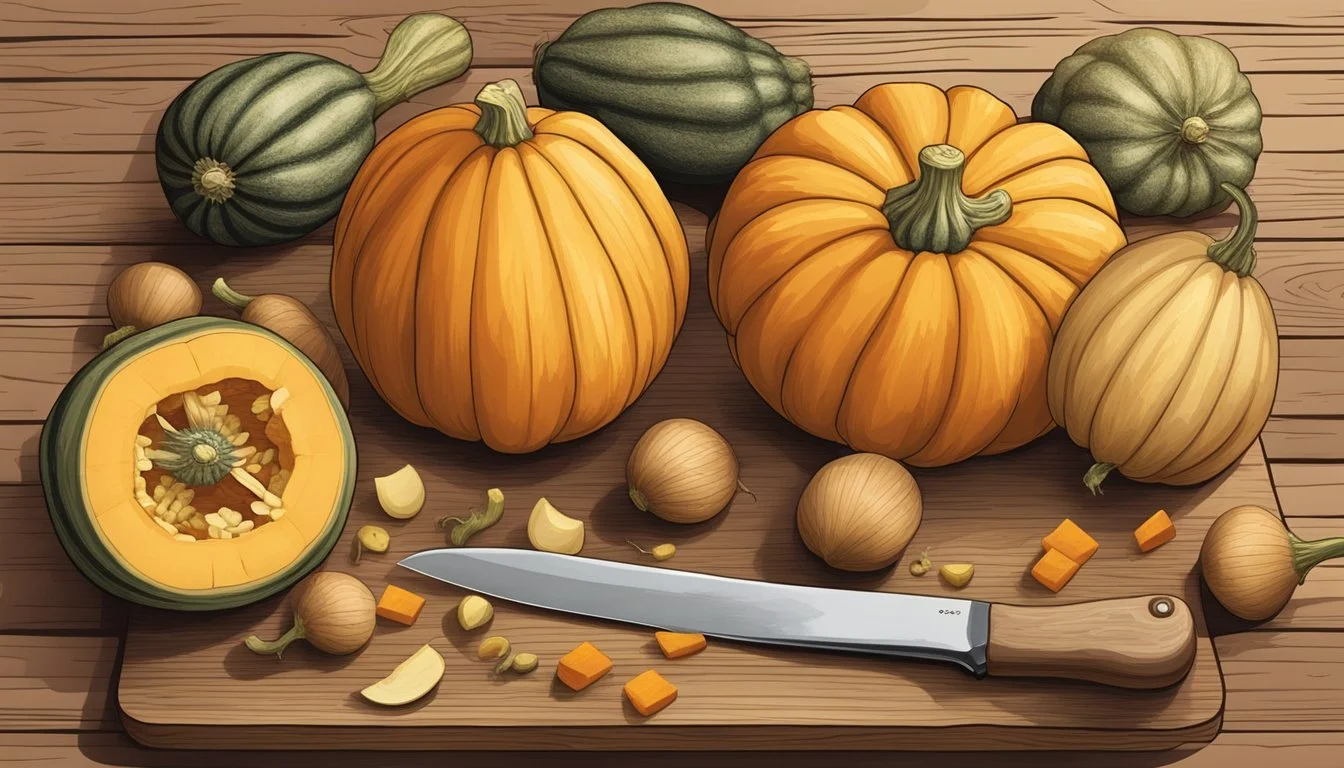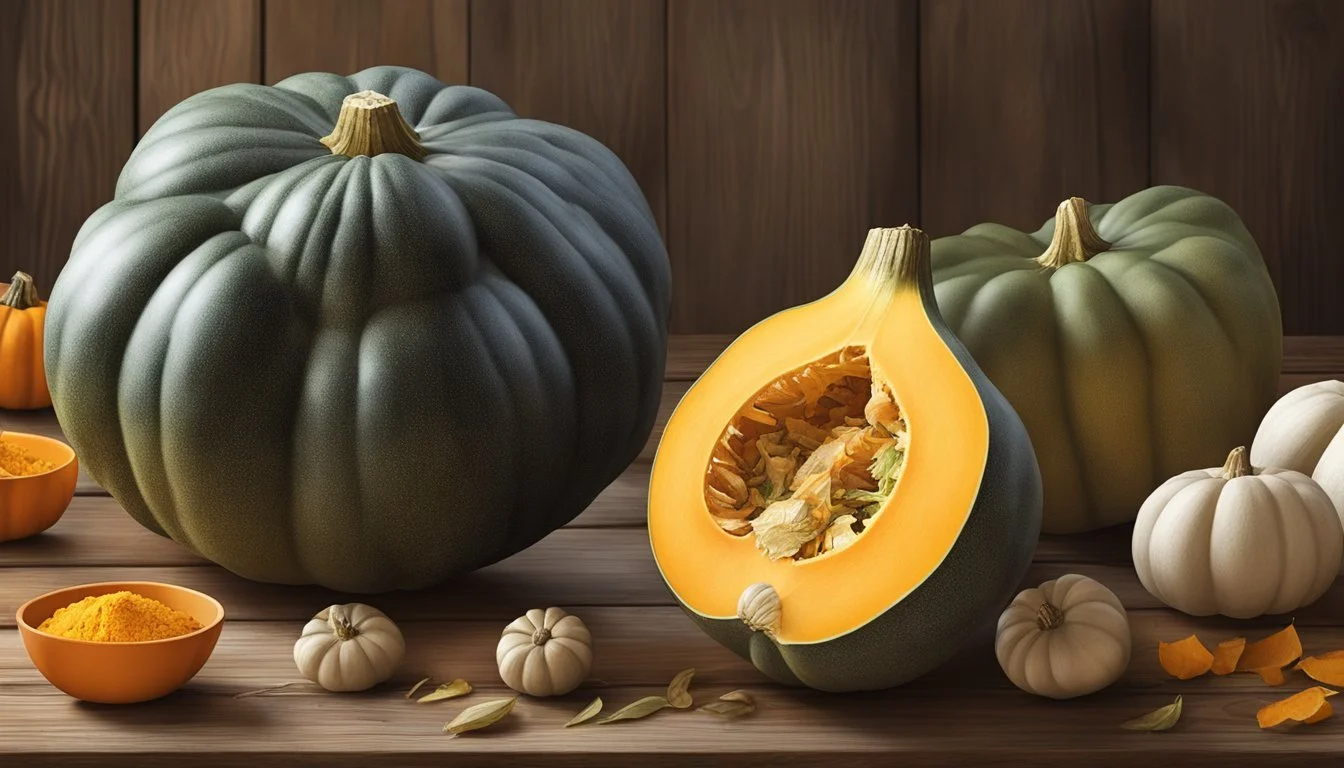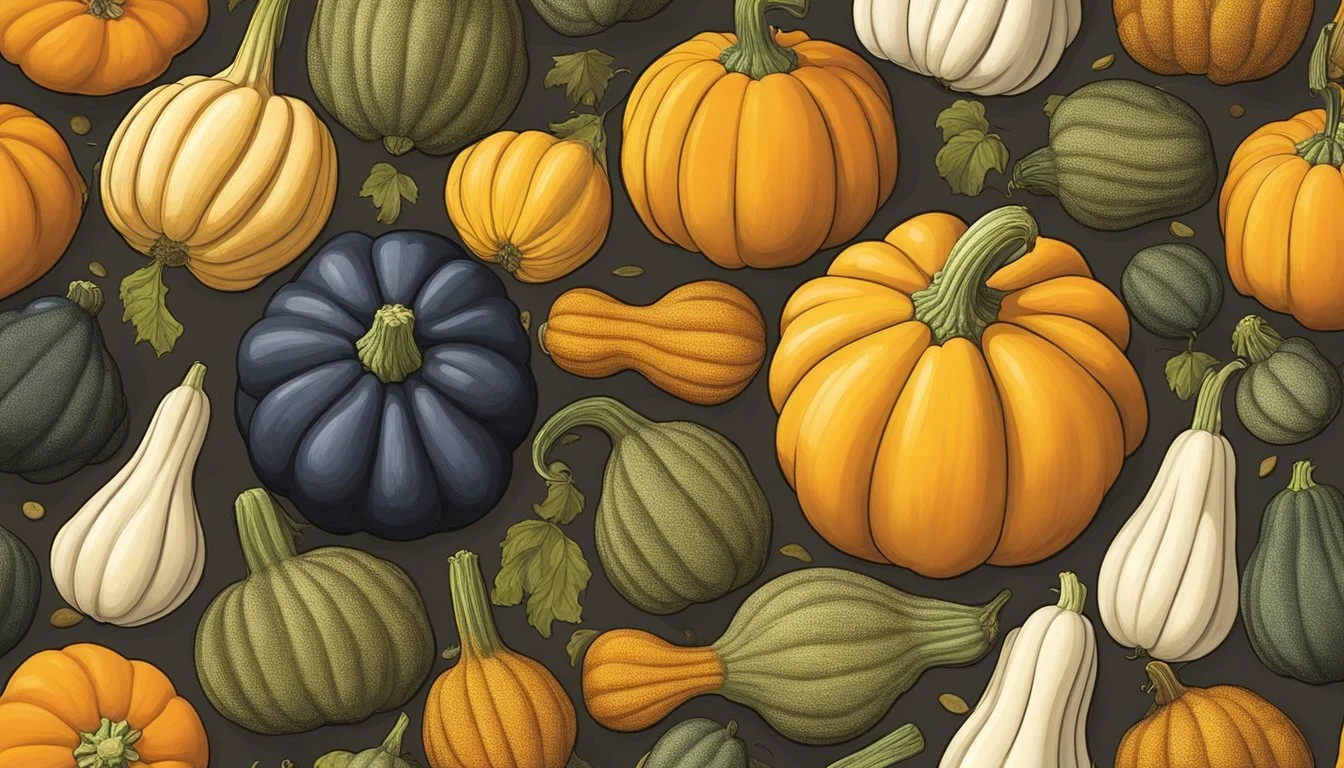Hubbard Squash Substitutes
Best Alternatives for Cooking
For those who relish the rich, sweet flavor of Hubbard squash but need a substitute, there are plenty of alternatives that can stand in. Carrots, eggplants, and potatoes can provide similar textures and flavors, making them apt replacements in a variety of dishes. Each substitute brings its own unique qualities, potentially enhancing the original recipe.
Pumpkin and butternut squash are particularly excellent substitutes for Hubbard squash. Their sweet and slightly nutty taste makes them versatile in recipes that typically call for Hubbard squash. Whether in soups, casseroles, or roasted dishes, these substitutes can seamlessly fill the gap without compromising on taste or texture.
For those looking for a different twist, combining wild rice or other whole grains with sweet potatoes or other winter squash varieties can yield delightful results. These combinations not only mimic the taste of Hubbard squash but also add a nutritional boost to your meals.
Understanding Hubbard Squash
Hubbard squash is a type of winter squash known for its large size and rich, nutty flavor. It is highly versatile in the kitchen and can be easily stored for extended periods.
Characteristics of Hubbard Squash
Hubbard squash is distinct for its substantial size, often weighing between five to 15 pounds. Its skin is typically matte and can range in color from deep green to bluish-gray. The flesh inside is orange and dense, which contributes to its rich flavor. When selecting Hubbard squash, look for those that are heavy for their size and avoid any with glossy skin. This indicates freshness and better quality.
Culinary Uses
Hubbard squash is quite versatile in culinary applications. It can be baked, roasted, steamed, or pureed. Its nutty and rich flavor makes it a popular choice for soups, stews, and casseroles. It can also be mashed, similar to potatoes. Some recipes utilize it as a substitute for other winter squashes like butternut or acorn squash. It works well in both savory and sweet dishes, including pies and breads.
Nutritional Profile
Hubbard squash is packed with nutrients. It is an excellent source of vitamins A and C, which are vital for immune function and skin health. It also provides a good amount of fiber, which aids in digestion. Additionally, it contains potassium, magnesium, and various antioxidants. These nutrients contribute to its health benefits, making it a nutritious choice for various meals.
Storage and Preservation
Proper storage is essential to maintaining the quality of Hubbard squash. It can be kept in a cool, dry place for several months, making it an excellent option for winter storage. Once cut, it should be wrapped and stored in the refrigerator, where it can last for up to a week. For longer preservation, Hubbard squash can be peeled, diced, and stored in the freezer for several months. Freezing it in portions allows for easy use in various recipes.
Substituting Hubbard Squash in Cooking
Substituting Hubbard squash requires careful attention to texture and flavor. Understanding the ideal substitutes and their substitution ratios ensures the best results in any recipe.
Factors to Consider When Substituting Hubbard Squash
Consider the texture and flavor profile of Hubbard squash. It has a dense, sweet, and nutty flavor that pairs well with various dishes. When choosing a substitute, sweet potatoes and butternut squash are top choices due to their comparable texture and taste.
Texture plays a significant role; the substitute should mirror the creamy consistency of cooked Hubbard squash. Both sweet potatoes and butternut squash excel in this aspect. Their natural sweetness enhances the flavor profile of soups, stews, and casseroles.
Substitution Ratio and Compatibility
When substituting, use a 1:1 ratio for most dishes. For instance, if a recipe calls for 1 cup of Hubbard squash, use 1 cup of sweet potatoes or butternut squash. This ensures the texture and flavor remain consistent.
Compatibility with other ingredients is also crucial. Sweet potatoes contain more sugar, so minor adjustments may be needed in recipes with sweet components. Butternut squash, with its similar cooking time and texture, often requires no further changes.
Some dishes, like roasted vegetables, benefit greatly from equal substitutions. For creamy soups, both substitutes blend well with minimal textural differences. Always test for seasoning adjustments, as the natural sweetness may shift the dish’s balance. This approach maintains the integrity and enjoyment of your culinary creations.
Best Hubbard Squash Substitutes
When Hubbard squash isn't available, there are several other types of squash and root vegetables that can work as effective substitutes. Each option provides a unique flavor and texture, making them suitable for a variety of dishes such as soups, stews, and casseroles.
Butternut Squash
Butternut squash is a popular substitute for Hubbard squash due to its sweet, nutty flavor. It has a smooth texture that blends well in purees and soups. Its medium size also makes it easy to handle and peel. Butternut squash is rich in vitamins A and C, adding nutritional value to meals. It’s versatile and can be roasted, steamed, or mashed, making it a perfect fit for many recipes that call for Hubbard squash.
Acorn Squash
Acorn squash has a mildly sweet and nutty flavor, similar to Hubbard squash. Its flesh is tender and works well in roasting and baking. The acorn squash's dark green skin and ribbed exterior contrast its bright orange interior. It is also packed with vitamins A and C and provides a good source of dietary fiber. This makes it a healthy alternative in recipes like stuffed squash or mixed vegetable dishes.
Pumpkin
Pumpkin, particularly sugar pumpkins, can be used as a substitute for Hubbard squash. Sugar pumpkins have a sweet, nutty flavor and a fine-grained texture that resembles Hubbard squash. They’re often used in soups, pies, and purees. Both vegetables share similar nutritional profiles, being high in fiber and vitamins A and C. When using pumpkin as a substitute, be sure to select ones meant for cooking rather than carving to avoid excessive wateriness.
Sweet Potato
Sweet potatoes offer a different but complementary sweetness and are a nutritious substitute for Hubbard squash. They are rich in fiber, vitamins A and C, and antioxidants. Sweet potatoes can be baked, mashed, or roasted, and their creamy texture and natural sweetness make them suitable for both savory and sweet dishes. Their bright orange flesh adds vibrant color to any meal while providing great health benefits.
Delicata Squash
Delicata squash, also known as sweet potato squash, is a smaller winter squash with a creamy texture and sweet flavor. It has an edible skin, which simplifies preparation. Delicata squash can be roasted or stuffed, and its flavor profile makes it a good substitute in many Hubbard squash recipes. It is lower in calories but still provides a good amount of vitamin C and fiber, making it a healthy option.
Kabocha Squash
Kabocha squash, also known as Japanese pumpkin, has a dense, dry texture and a sweet, rich flavor. It's similar to Hubbard squash but with a more pronounced sweetness. It can be roasted, steamed, or used in soups. Kabocha is high in vitamins A and C and provides a good dose of dietary fiber. Its green, bumpy skin can be eaten when cooked, adding a unique texture to dishes.
Considerations for Specific Dishes
Selecting the best substitute for Hubbard squash depends on the dish being prepared. Different alternatives excel in unique culinary contexts such as soups, stews, roasts, baked goods, pies, desserts, and purees.
Substitutes in Soups and Stews
For soups and stews, butternut squash and sweet potatoes are excellent substitutes. Butternut squash has a creamy texture and a slightly sweet flavor, which closely matches that of Hubbard squash. Sweet potatoes, while slightly sweeter and denser, meld well into these dishes, providing a robust texture and flavor.
Kabocha squash is another reliable option, offering a sweetness and texture similar to butternut squash. It holds up well during slow cooking, making it ideal for hearty stews. For a subtle flavor variation, try using acorn squash, though it's slightly less sweet and more fibrous.
Substitutes for Roasting and Baking
When roasting or baking, butternut squash and kabocha squash are top contenders due to their similar texture and cook times. Butternut squash’s sweet, nutty flavor and smooth texture make it perfect for these methods. Kabocha squash, known for its drier, dense flesh, caramelizes beautifully when roasted.
Sugar pumpkins (pie pumpkins) are also an appropriate choice. They are less watery than carving pumpkins and provide a slightly sweet, smooth texture when baked. For a different twist, acorn squash can be used, although it may require additional seasoning to match the robust flavor profile of Hubbard squash.
Substitutes in Pies and Desserts
Pies and desserts benefit from the smooth, sweet nature of sugar pumpkins and butternut squash. Sugar pumpkins, often called pie pumpkins, offer a sweet, creamy base that perfectly complements spices like cinnamon and nutmeg. Butternut squash puree is similarly smooth and sweet, ensuring a seamless substitution.
Sweet potatoes, with their natural sweetness and creamy texture, can also stand in for Hubbard squash in pies and desserts. They work particularly well in recipes that call for additional sweeteners or spices. For a unique flavor, try kabocha squash, which brings a rich, nutty sweetness to desserts.
Substitutes for Purees and Mashes
For purees and mashes, butternut squash and sweet potatoes are ideal choices. Their soft, creamy texture when cooked makes them easy to mash and puree, similar to Hubbard squash. Butternut squash’s mild sweetness enhances savory and sweet dishes alike.
Kabocha squash is another excellent alternative, providing a dense, creamy texture that works well in purees. Acorn squash can also be pureed or mashed, although it may require additional butter or cream to achieve the desired consistency and richness.
Preparation Tips for Squash Substitutes
Cooking squash substitutes effectively often requires adjusting cooking times, tweaking seasonings, and exploring alternative cooking methods. Here are some practical tips to help you prepare your dish with the best possible results.
Adjusting Cooking Times
Different squash substitutes like sweet potatoes, spaghetti squash, and kabocha squash may vary in their cooking times. For example, sweet potatoes generally take longer to roast than delicata squash due to their denser texture.
Roasting: Sweet potatoes may need 45 minutes at 400°F, while delicata squash can be done in 25-30 minutes at the same temperature.
Steaming: Medium cubes of kabocha squash take about 20 minutes to become tender.
Boiling: Boiling sweet potatoes will require approximately 15 minutes, whereas spaghetti squash can be boiled in around 20-25 minutes.
Seasoning Recommendations
Seasoning your squash substitutes correctly enhances their natural flavors. Here’s how you can use common ingredients:
Butter and Olive Oil: Using butter on butternut squash substitutes like kabocha can bring out its nutty flavor. Olive oil works well for roasting summer squash substitutes like zucchini.
Salt and Pepper: A simple seasoning of salt and pepper is essential. Salt penetrates the squash, elevating its sweetness, while pepper adds a slight zing.
Herbs and Spices: For a twist, consider adding rosemary or thyme for an aromatic flavor, or a sprinkle of cinnamon on sweet potatoes for warmth.
Alternative Cooking Methods
Exploring different cooking methods can bring unique textures and flavors to your squash substitutes.
Roasting: Roasting squash substitutes like spaghetti squash and delicata brings out their natural sweetness. Toss slices in olive oil, salt, and pepper before roasting for a caramelized finish.
Steaming: Steaming is effective for sweet potato cubes, making them tender while preserving nutrients. Lightly season with salt and butter after steaming.
Sautéing: Thin slices of kabocha squash can be sautéed in olive oil with garlic. This method ensures a quick and flavorful dish with a bit of crispness.
By fine-tuning these aspects, you can ensure that your squash substitutes turn out delicious and suit your recipes perfectly.
Health and Dietary Considerations
Choosing a substitute for Hubbard squash involves understanding the caloric and nutrient profiles of potential substitutes, addressing allergy and intolerance concerns, and knowing how to incorporate these alternatives efficiently into diets.
Caloric and Nutrient Comparisons
Hubbard squash is known for its rich nutrient content, including a good amount of dietary fiber, potassium, and vitamin C. Comparatively, butternut squash, one common substitute, also boasts high levels of vitamin A, and fiber, making it a healthy alternative.
Similarly, acorn squash offers a slightly higher fiber content along with essential nutrients like magnesium. When considering caloric intake, Hubbard squash and its substitutes are fairly similar, making them interchangeable without significant caloric differences. This helps maintain balanced meals without drastic changes in nutritional value.
Allergies and Intolerances
Allergies to squash and its substitutes are relatively rare but not impossible. Individuals with a known allergy to any member of the squash family should consult their doctor before making substitutions.
Cross-reactivity can occur with other fruits and vegetables like melons, cucumbers, and bananas. Symptoms may include itching, swelling, or digestive discomfort. For those with mild intolerances, cooking the squash thoroughly can sometimes reduce adverse reactions.
Incorporating Squash Substitutes in Diets
Incorporating substitutes for Hubbard squash in diets can be straightforward. For savory dishes, roasting or steaming acorn or butternut squash preserves most nutrients while enhancing flavor. These squash varieties can be pureed for soups or used in casseroles.
For baking, sugar pumpkins lend a sweet, smooth texture suitable for pies and breads. Substituting these in a 1:1 ratio generally works well and maintains recipe integrity. Organic options may offer slightly higher nutrient content and fewer pesticides, which is an added benefit for health-conscious individuals.
By selecting the right substitute and method of preparation, individuals can enjoy the health benefits of squash without significant dietary adjustments.







